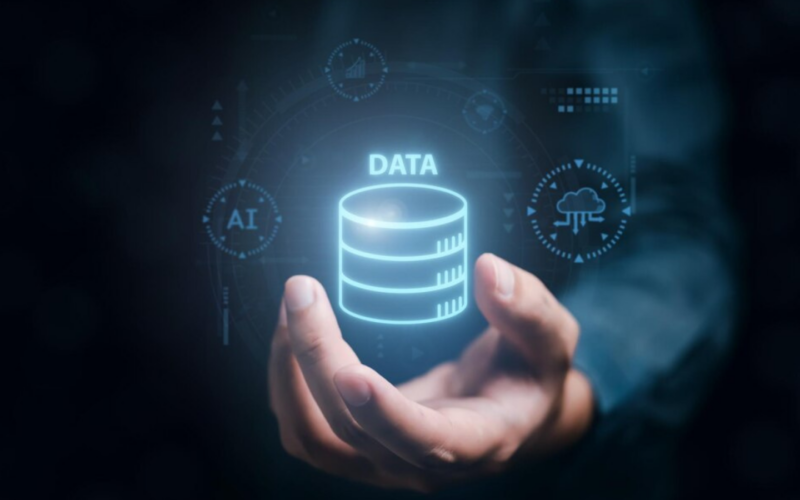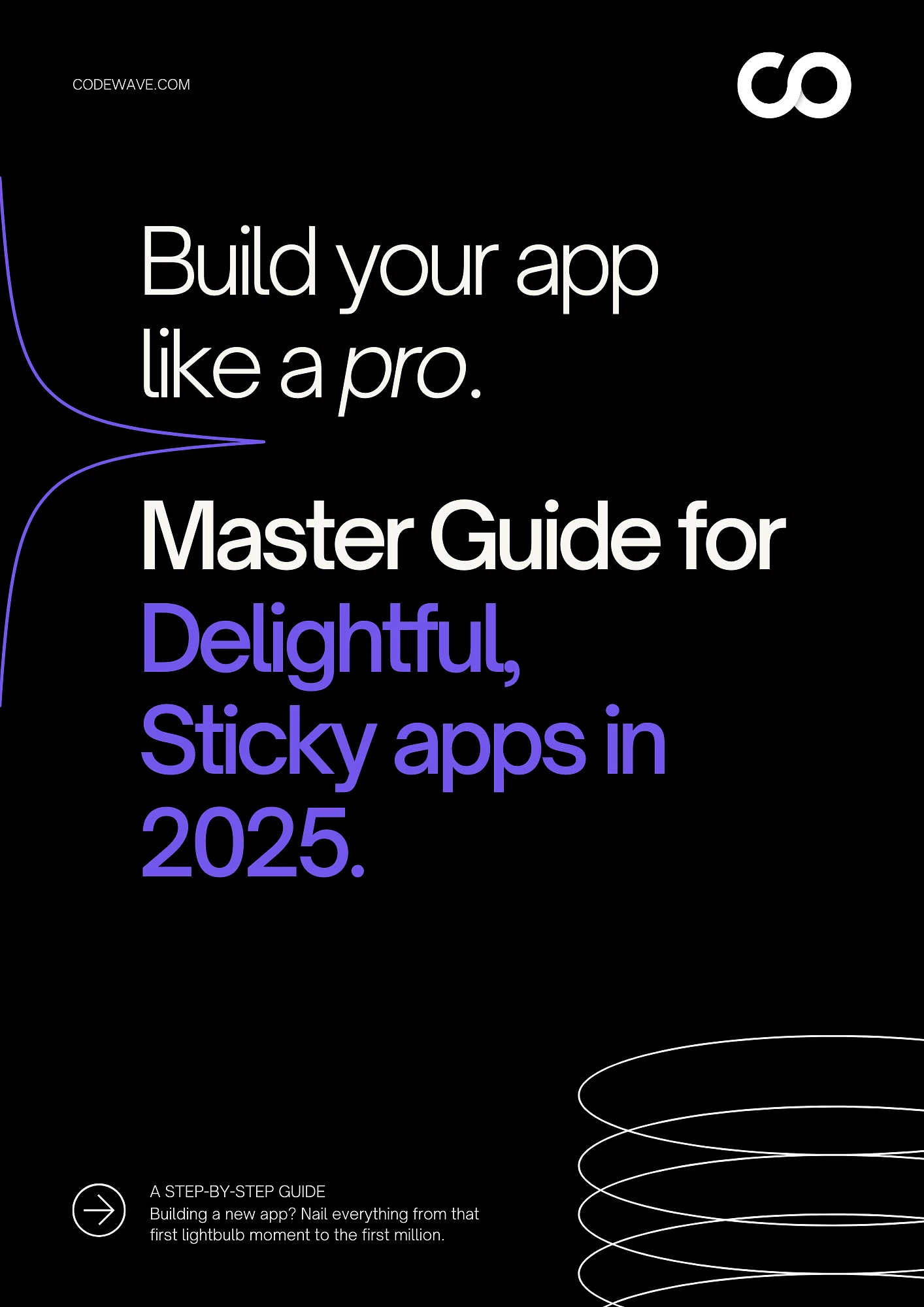Every time your customers check their account balance, track an order, or stream content, a database management system (DBMS) is working behind the scenes to store, sort, and serve data in real-time. In 2024, relational databases led the pack, making up 61.74% of total DBMS revenue worldwide.
However, choosing thebest data base solution today involves more than just picking the most popular option. With various types and tools available, the decision can be overwhelming.
This guide walks you through the top database categories, tools, and selection tips so that you can pick the right fit for your app, your data, and your team.
- The best data base depends on your app’s structure, growth plans, and team skills, not just features.
- Relational, NoSQL, NewSQL, and Serverless DBMS options each serve different needs.
- Use case, scale, team familiarity, and non-negotiables should guide your decision.
- Codewave can help you choose, set up, and scale the right DBMS for your product from day one.
DBMS Categories and the Best Picks Under Each
You’re building an app and things are going well. Until you hit the part where data starts piling up. Users are signing up, orders are flying in, and suddenly your app feels slower. Maybe it’s crashing when traffic spikes. Or your team is spending hours writing workarounds just to get basic queries to run right. That’s usually a sign you didn’t pick the right database from the start.
At Codewave, we help you sort through the noise and pick the one that actually fits your app, so you can build faster, scale smarter, and stay focused on what matters.
Below is a clear breakdown of DBMS categories and the best data base options under each.
Relational (RDBMS)
If your app depends on structured data, clear relationships, and reliable transactions, relational databases are still your safest bet. They’ve been around for decades for a reason.
Here are some of the most trusted RDBMS tools you can count on:
1. PostgreSQL
PostgreSQL is a powerful, open-source RDBMS known for its reliability, extensibility, and standards compliance.
- Ideal For: Developers who need SQL + NoSQL support, and teams building complex applications with strong data integrity
- ACID Compliance: Yes
- Query Language: SQL (with support for JSON, XML, full-text search, and custom functions)
- Cloud Support: Available via AWS RDS, Azure, Google Cloud SQL, Heroku, and more
- Pros and Cons
| Pros | Cons |
| Free and open-source | Can be slower than NoSQL for certain workloads |
| Highly extensible (PostGIS, TimescaleDB) | Manual tuning required at scale |
| Strong community and documentation | Slightly steeper learning curve for newcomers |
2. MySQL / MariaDB
MySQL (and its community-driven fork MariaDB) is a fast, lightweight RDBMS that’s long been a go-to choice for web applications and CMS platforms.
- Ideal For: Web developers, small-to-medium apps, WordPress, and LAMP stack projects
- ACID Compliance: Yes (with InnoDB engine)
- Query Language: SQL
- Cloud Support: AWS RDS, Google Cloud SQL, Azure, DigitalOcean Managed DB, etc.
- Pros and Cons
| Pros | Cons |
| Easy to set up and manage | Fewer features than PostgreSQL for complex workloads |
| Fast read performance | Not ideal for very large datasets or high write loads |
| Broad community and hosting support | Complex joins and subqueries can be less efficient |
3. SQL Server
Microsoft SQL Server is a feature-rich, enterprise-grade RDBMS designed for transactional systems, reporting, and business intelligence, especially in Windows environments.
- Ideal For: Enterprise apps, BI and analytics-heavy platforms, Windows-based environments
- ACID Compliance: Yes
- Query Language: T-SQL (Transact-SQL)
- Cloud Support: Fully supported on Microsoft Azure SQL Database, also deployable on AWS and GCP
- Pros and Cons
| Pros | Cons |
| Strong integration with Microsoft tools | Licensing can be expensive |
| Rich BI and reporting features | Heavier system requirements |
| Reliable performance and security | Limited flexibility outside Windows stack |
4. Oracle DB
Oracle Database is a high-performance RDBMS built for large-scale enterprise applications that need speed, security, and advanced analytics.
- Ideal For: Mission-critical enterprise systems, large-scale transactional apps, high-security industries
- ACID Compliance: Yes
- Query Language: SQL with PL/SQL support
- Cloud Support: Oracle Cloud Infrastructure (OCI), plus support for AWS and Azure deployments
- Pros and Cons
| Pros | Cons |
| Extremely stable at high volumes | Complex licensing and high cost |
| Strong in analytics, clustering, and replication | Steep learning curve |
| Advanced performance tuning capabilities | Overkill for smaller apps or teams |
Can’t get clear answers from messy, scattered data? Check out Codewave’s Data Analytics Development services and let us build dashboards and reports that bring clarity.
NoSQL
When your data doesn’t fit neatly into rows and columns, or when speed and flexibility matter more than strict structure, that’s where NoSQL steps in. It’s built for scale, for change, and for handling messy, semi-structured, or even unstructured data without breaking a sweat.
Below are the most widely used types, along with the best data base options under each.
1. MongoDB
MongoDB is a document-based NoSQL database that stores data in flexible, JSON-like documents. It’s schema-less, which makes it ideal for apps that evolve quickly or deal with varied data formats.
- Ideal For: Developers building modern web/mobile apps, content-heavy platforms, or fast-changing data models
- ACID Compliance: Yes (at the document level)
- Query Language: MongoDB Query Language (MQL), also supports aggregation pipelines
- Cloud Support: Fully managed with MongoDB Atlas (AWS, Azure, GCP), or self-hosted
- Pros and Cons
| Pros | Cons |
| Flexible schema—easy to update on the fly | Less efficient for highly relational data |
| Great for rapid prototyping | Write-heavy workloads may need tuning |
| Rich query and indexing support | Document size limit (16MB) can be restrictive |
2. Couchbase
Couchbase combines document storage with key-value performance and SQL-like querying through N1QL. It’s known for its offline sync and mobile database capabilities.
- Ideal For: Mobile-first apps, distributed systems, or projects needing both key-value speed and document flexibility
- ACID Compliance: Yes (on single-document operations)
- Query Language: N1QL (SQL-like syntax for JSON)
- Cloud Support: Couchbase Capella (managed DBaaS), self-hosted, edge deployment supported
- Pros and Cons
| Pros | Cons |
| Blends document and key-value storage | Smaller developer ecosystem compared to MongoDB |
| Built-in mobile sync via Couchbase Lite | Steeper learning curve for N1QL |
| Fast, memory-first architecture | Costly at enterprise scale |
3. Redis
Redis is a lightning-fast, in-memory key-value store often used for caching, pub/sub systems, and ephemeral session data. It supports data structures like hashes, lists, and sorted sets.
- Ideal For: Caching layers, leaderboard systems, messaging queues, real-time analytics
- ACID Compliance: No
- Query Language: Redis Commands (not SQL or document queries)
- Cloud Support: Available via Redis Enterprise Cloud, AWS ElastiCache, Azure Cache for Redis
- Pros and Cons
| Pros | Cons |
| Extremely fast in-memory performance | Not suitable for long-term storage |
| Simple and lightweight | Lacks complex query capabilities |
| Great support for pub/sub, TTLs | Limited data persistence without tweaks |
4. DynamoDB
DynamoDB is Amazon’s serverless NoSQL database that supports key-value and document data models. It’s built for massive scale with minimal ops overhead.
- Ideal For: Serverless apps, high-traffic workloads, globally distributed systems
- ACID Compliance: Yes (with transactional API)
- Query Language: PartiQL (SQL-compatible)
- Cloud Support: AWS-only (fully managed, no self-hosted option)
- Pros and Cons
| Pros | Cons |
| Auto-scaling and serverless | Locked into AWS ecosystem |
| Built-in replication and backup | Can get expensive with high read/write units |
| Supports both key-value and document | Limited indexing and joins |
NewSQL
You want the reliability of SQL but the scale and flexibility of NoSQL. That’s where NewSQL steps in. It’s built for teams that need strong consistency, familiar relational models, and the ability to grow without rewriting everything later.
If you’re building a fast-growing app that needs to stay consistent across regions, these are the best data base options under the NewSQL category worth exploring:
1. CockroachDB
CockroachDB is a distributed SQL database designed for high availability and global scalability. It automatically replicates, balances, and recovers data across nodes, making it ideal for apps that can’t afford downtime.
- Ideal For: Transaction-heavy apps, SaaS platforms, and global applications that need built-in failover
- ACID Compliance: Yes (full transactional support)
- Query Language: Standard SQL
- Cloud Support: CockroachDB Cloud (fully managed), self-hosted, Kubernetes-ready
- Pros and Cons:
| Pros | Cons |
| High fault tolerance and self-healing | Can be complex to fine-tune for performance |
| Strong consistency across distributed nodes | Higher latency in multi-region writes |
| Compatible with PostgreSQL tools | Learning curve for ops teams |
2. YugabyteDB
YugabyteDB offers a PostgreSQL-compatible SQL API on top of a distributed storage engine. It supports high-throughput transactional workloads and is built to handle both OLTP and distributed workloads efficiently.
- Ideal For: Apps needing horizontal scale with strong consistency—like fintech platforms or multi-tenant SaaS
- ACID Compliance: Yes
- Query Language: SQL (PostgreSQL-compatible), plus YCQL and YSQL APIs
- Cloud Support: Self-hosted, Kubernetes, and YugabyteDB Managed (cloud offering)
- Pros and Cons:
| Pros | Cons |
| Multi-API support for flexibility | Still maturing compared to PostgreSQL |
| Scales horizontally with no downtime | Limited third-party integrations |
| Built-in global distribution features | Needs careful config for write-heavy loads |
3. Google Cloud Spanner
Cloud Spanner is Google’s fully managed, globally distributed SQL database. It combines the scalability of NoSQL with the transactional guarantees of traditional RDBMSs, offered as a service with minimal ops.
- Ideal For: Enterprises building globally distributed apps that require strong consistency and automatic scaling
- ACID Compliance: Yes (full transactional support with external consistency)
- Query Language: SQL (Spanner SQL dialect)
- Cloud Support: Available only on Google Cloud Platform
- Pros and Cons:
| Pros | Cons |
| Fully managed with seamless global scale | GCP-only—no self-hosted version |
| Automatic sharding and scaling | Higher entry-level pricing |
| Excellent uptime and availability | Less flexibility for custom tuning |
Cloud-Native / Serverless
If you don’t want to worry about provisioning, scaling, or patching your database, cloud-native and serverless options take that load off your shoulders. These databases are built to grow with your app, handle traffic spikes without breaking, and bill you only for what you use.
Here are some of the best data base tools in this category worth checking out:
1. Amazon Aurora Serverless
Aurora Serverless is a scalable, on-demand version of Amazon’s cloud-native relational database. It automatically adjusts capacity based on your app’s load, so you only pay for what you use.
- Ideal For: Apps with unpredictable or bursty traffic, startups that need cost-efficient scale
- ACID Compliance: Yes
- Query Language: SQL (MySQL- and PostgreSQL-compatible versions)
- Cloud Support: AWS-only (fully managed by Amazon RDS)
- Pros and Cons:
| Pros | Cons |
| Auto-scaling without downtime | Cold starts can affect performance |
| Compatible with MySQL and PostgreSQL tools | Locked into AWS ecosystem |
| Built-in replication, backups, and failover | Limited tuning compared to standard Aurora |
2. PlanetScale
PlanetScale is a serverless MySQL-compatible database built on Vitess (used by YouTube). It’s designed for developers who want zero-downtime schema changes, instant branching, and massive scalability without managing shards.
- Ideal For: Developers building scalable web apps with CI/CD workflows, especially in fast-paced dev teams
- ACID Compliance: Yes
- Query Language: SQL (MySQL-compatible)
- Cloud Support: Fully managed, hosted by PlanetScale on cloud infrastructure (no self-hosted version)
- Pros and Cons:
| Pros | Cons |
| Schema changes without downtime | Lacks some advanced MySQL features (e.g., triggers) |
| Git-style branching for development | Locked into PlanetScale’s platform |
| Great for fast-moving teams and large scale | Not ideal for complex, deeply relational models |
3. Google Firestore
Firestore is a fully managed, serverless NoSQL database from Google Cloud, designed for real-time apps. It stores data in flexible documents and collections, and syncs changes across devices in milliseconds.
- Ideal For: Real-time mobile/web apps, chat systems, offline-first apps
- ACID Compliance: Yes (document-level)
- Query Language: Firestore query syntax (NoSQL-style)
- Cloud Support: Google Cloud Platform only
- Pros and Cons:
| Pros | Cons |
| Real-time syncing and offline support | Complex queries and joins are limited |
| Easy integration with Firebase SDKs | Pricing can spike with heavy reads/writes |
| Great for mobile and multi-user apps | GCP-only; vendor lock-in |
Manual processes slowing down your decision-making? Explore Codewave’s AI/ML Development services and let us build models that automate data handling, spot trends, and accelerate insights.
Once you’ve seen what each type offers, it’s time to figure out which one actually suits your project.
Choosing the Right DBMS for Your Project
You’re running a fast-growing ecommerce site. At first, everything works fine. Then your catalog grows, customer activity spikes, and suddenly product searches slow down or break. Your team patches things with caching and quick fixes, but the core issue lingers, your database can’t keep up with the way your data behaves.
Choosing the best data base starts with knowing what your app actually demands, not just now, but six months from now.
Here’s how to make that call with clarity.
1. Start with Your Use Case
Don’t start by comparing features. Start with your app. A chat app with high-speed messaging needs a very different setup than a slow-growing marketplace. Thinking this through early saves you from major rewrites down the road.
Focus on:
- What kind of app is it?
- How much traffic are you expecting?
- Is your data structured, semi-structured, or all over the place?
- Do you care more about fast reads, safe writes, or real-time sync?
Here’s a quick cheat sheet:
| App Type | Best Fit DBMS |
| E-commerce backend | PostgreSQL, MySQL, CockroachDB |
| IoT sensor data | InfluxDB, TimescaleDB |
| AI/ML app backend | MongoDB, Fauna, Pinecone |
| Real-time chat | Redis, DynamoDB |
| Complex relationships | Neo4j, Amazon Neptune |
2. Define Your Non-Negotiables
It’s easy to get distracted by benchmarks and shiny features. But what really matters is what you can’t compromise on. Maybe you need SQL support because your team already knows it. Maybe cost is a blocker. Maybe you can’t risk being stuck in a single cloud ecosystem.
Checklist:
- SQL support: yes or no?
- Is global availability a must?
- Open-source or fine with managed?
- Is vendor lock-in a dealbreaker?
- What’s your hard budget?
3. Consider the Team’s Skillset
You don’t want your devs learning a new query language in the middle of a product sprint. The best database is the one your team can actually use well. If you don’t have a DevOps team, a fully-managed option might be the only way to go.
If your backend engineers live in SQL, don’t throw them into a NoSQL setup unless you really need to.
Think about:
- What languages and tools does your team already know
- Whether you can afford to manage infrastructure
- How much support you’ll need during rollout
4. Think About Scale
Your app might not need to scale on day one. But what happens if it takes off next quarter? Some databases crumble when hit with unexpected traffic, others handle scale effortlessly.
Ask yourself:
- How fast is your data growing?
- Do you need to support multi-region traffic?
- Do you need horizontal scaling from the start?
5. Evaluate Ecosystem and Support
No tool works in isolation. Your database should work well with the stack you’ve already chosen, and it should have a support system you can rely on when things break.
Look for:
- Good docs and active developer forums
- Compatibility with your current tools
- Third-party tools or libraries you may need later
6. Security & Compliance Requirements
Some projects can’t afford loose ends. If you’re dealing with personal data, financial records, or anything sensitive, your DBMS needs to meet a higher standard.
Check for:
- ACID support for safe transactions
- Built-in encryption (at rest and in transit)
- Compliance options for HIPAA, GDPR, PCI-DSS, or whatever your industry requires
Start small. Test with sample data. Try the free tiers. Benchmark a few options before you lock one in. The best data base is the one your app and team can work with, now and six months from now.
Off-the-shelf tools not fitting your workflow? Check out Codewave’s Custom Software Development services, we build solutions tailored to how your business actually runs.
Once you’ve got a handle on the basics, you can look into query tuning, caching layers, or using vector databases for AI use cases.
Why Choose Codewave for Database Management Solutions?
Choosing the best data base isn’t just about picking the right tool, it’s about setting up the right foundation for your product to grow. At Codewave, we design end-to-end data architectures that match your app’s pace, scale, and complexity.
From relational systems to NoSQL, serverless, and distributed setups, we help you choose wisely, set it up right, and keep it running smoothly.
Want to see how we’ve helped teams like yours solve real data challenges? Check out our portfolio and see what’s possible when you build with clarity from day one.
What you get with Codewave’s Database Management Services:
- 60% faster setup of the right database architecture for your app
- 3x quicker deployment, so your product moves from dev to production without delays
- Save up to 3 weeks a month by automating backups, scaling, and performance tuning
- 25% lower development costs through smart database design and AI-assisted query optimization
Our services include:
- Data Strategy Consultation: We help you assess your current data flow, understand your app’s needs, and design a roadmap that scales with your growth, without overcomplicating things.
- Database Architecture & Development: From choosing the best data base to setting up schema, replication, and backups, we handle the full setup, tuned for performance and reliability.
- AI-Powered Data Solutions: We bring AI into the mix to optimize query performance, enable real-time analytics, and help your systems learn from usage patterns.
- Dashboards & Reporting Tools: We build clean, interactive dashboards that turn your raw data into insights your team can act on, fast. No SQL skills needed.
Curious to see what your data is really capable of? Book a free demo with Codewave’s experts and discover how we can turn your data into real results.
FAQs
Q. What’s the difference between relational and NoSQL databases?
A. Relational databases (like MySQL and PostgreSQL) store data in tables with predefined schemas, making them ideal for structured data and transactions.
NoSQL databases (like MongoDB and Cassandra) store unstructured data in flexible formats like key-value pairs, documents, or graphs, offering scalability and high performance for big data applications and real-time analytics.
Q. How do cloud-based databases compare to traditional on-premises databases?
A. Cloud-based databases like Amazon RDS and Google Cloud Firestore offer benefits such as easy scalability, reduced hardware costs, and automatic updates. They allow businesses to focus on development rather than infrastructure management. Traditional on-premises databases provide more control but come with higher setup and maintenance costs, making them less flexible for rapidly growing businesses.
Q. How important is database security in 2025?
A. Database security is critical as businesses handle more sensitive data. With increased cyber threats, ensuring data privacy and integrity is a top priority. Look for databases with built-in encryption, role-based access control, and audit logging. Cloud databases often provide enhanced security features, but you still need to ensure compliance with regulations like GDPR or CCPA.
Q. Can AI and machine learning improve database management?
A. Yes, AI and machine learning can significantly enhance database management by automating routine tasks, detecting anomalies, and optimizing queries. For example, predictive analytics can forecast data growth, while machine learning models can automatically optimize database indexing and query performance, reducing manual intervention and improving overall efficiency.
Q. How can emerging database technologies impact business operations in 2025?
A. Emerging database technologies, such as distributed databases and in-memory databases, can significantly boost business operations in 2025 by offering faster data access, enhanced real-time processing, and better handling of large datasets. These technologies reduce latency and improve decision-making speeds, particularly for businesses dealing with high-volume transactions or complex data processing.
Codewave is a UX first design thinking & digital transformation services company, designing & engineering innovative mobile apps, cloud, & edge solutions.







